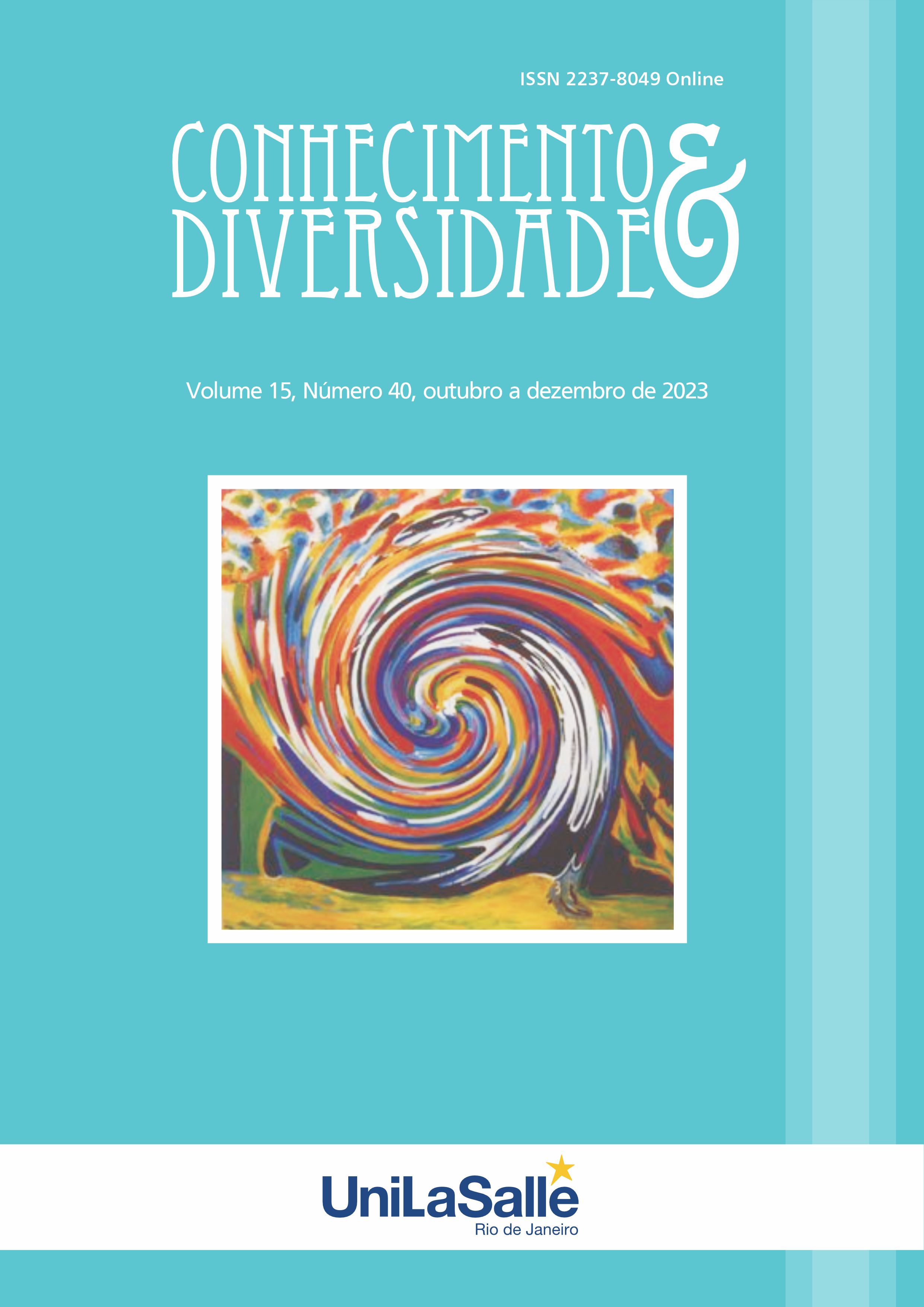ASPECTOS SOCIOLINGUÍSTICOS DA INTERAÇÃO VERBAL
EXPLORANDO COMUNIDADES LINGUÍSTICAS E PRÁTICAS DE FALA
DOI:
https://doi.org/10.18316/rcd.v15i40.11247Palavras-chave:
Ensino superior, Inovação, Comunidade linguística, Motivação, Sociolinguística, Prática de falaResumo
O estudo das comunidades linguísticas, onde as práticas linguísticas estão subordinadas ao comportamento social e moldadas por inovações e tradições linguísticas, abre um amplo espaço para a investigação em sociolinguística. Por esta razão, focar e estudar comunidades linguísticas e implementar práticas linguísticas como meio de aprendizagem é relevante para a linguística. O estudo visa estabelecer a eficácia da incorporação de conquistas sociolinguísticas no trabalho com estudantes de linguística. Em particular, inclui uma investigação das especificidades da interação verbal e o estudo do comportamento comunicativo das comunidades linguísticas e das práticas de fala. Envolve uma análise da eficácia de envolver os alunos no processo de pesquisa e inovar sua motivação para estudar sociolinguística. A metodologia de pesquisa baseia-se em uma abordagem abrangente, utilizando observação, métodos descritivos, análise e síntese. O principal método empregado é um experimento. Além disso, uma avaliação da implementação da nova metodologia inclui pesquisas realizadas na fase final. A hipótese principal do estudo pressupõe que a utilização de teorias sociolinguísticas durante a pesquisa e o trabalho educativo com os alunos é uma prática acadêmica eficaz. Além disso, a aplicação do estudo das comunidades linguísticas e dos modelos de prática da fala é necessária para um especialista em linguística. Mais pesquisas seriam promissoras se considerassem a experiência de projetos de pesquisa bem-sucedidos de estudantes, bem como estudos dos aspectos linguísticos da interação social nas práticas educacionais universitárias. Em particular, o processo de preparação e implementação de projetos de equipa na educação é a chave para garantir um ambiente amigável para todos os participantes no processo educativo.
Referências
Ahlgren, K., & Rydell, M. (2020). Continuity and change. Migrants' experiences of adult language education in Sweden. European Journal for Research on the Education and Learning of Adults, 11(3), 399-414. Available at: http://doi.org/10.3384/rela.2000-7426.ojs1680.
Ahmad, F. (2019). Sociolinguistics in language teaching. MABASAN, 9(2), 66-77 Available at: http://doi.org/10.26499/mab.v9i2.159
Arbol del, E. (2018). Innovative Teaching Methods in Specialised Translation. Modern Journal of Language Teaching Methods, 8(12), 426-436. Available at: http://doi.org/10.26655/mjltm.2
Blommaert, J. (2010). The sociolinguistics of globalization. Cambridge University Press, 213.
Bruin, A., Treccani, B., Sala, S. (2016). Cognitive Advantage in Bilingualism An Example of Publication Bias? Psychological Science, 26(1), 99-107 Available at: http://doi.org/56797614557866.
De Meulder, M. & Murray, J. (2017). Buttering their bread on both sides? The recognition of sign languages and the aspirations of deaf communities. Language Problems & Language Planning, 41(2), 136-158. Available at: http://doi.org/10.1075/lplp.41.2.04dem
Fejes, A. (2017). Dahlstedt Popular education, migration and a discourse of inclusion. Studies in the Education of Adults, 49(2), 214-227. Available at: http://doi.org/10.1080/02660830.2018.1463656
Gasparri, L., & Murez, M. (2021). Hearing meanings: the revenge of context. Synthese, 198(6), 5229-5252.
Gilakjani, А. (2016). А review of EFL learners’ speaking skill and the strategies for improvement. Modern Journal of Language Teaching Methods (MJLTM), 6(9), 56-63. Available at: http://doi.org/10.26655/mjltm.2016.12.1
Goh, C. C. M., & Burns, A. (2012). Teaching speaking: A holistic approach. New York: Cambridge, 301 p.
Herk, Van G. (2015). Sociolinguistics. International Encyclopedia of the Social & Behavioral Sciences, 949-953. Available at: https://doi.org/10.1016/B978-0-08-097086-8.53081-5.
Jackendoff, R., & Jackendoff, R. S. (2002). Foundations of language: Brain, meaning, grammar, evolution. Oxford University Press, USA.
Ko, J., Sammons, P., Bakkum, L. (2013). Effective Teaching: a review of research and evidence. CfBT Education Trust. Available at: http://cdn.cfbt.com/~/media/cfbtcorporate/files/research/2013/reffective-teaching-2013.pdf
Köktürk, Ş. (2012). Forms and Multifunctionality of Interruptions and Simultaneous Speaking in Ordinary Talk – proposal of a Universal Model for the Evaluation of Interruptive Speech Sequences. International Journal of Linguistics, 4(3), 551-571. Available at: http://doi.org/10.5296/ijl.v4i3.2137U
Kostusiak, N., Shulska, N., Lisova, Y., Yaresko K., Ivanova, I., Pochuieva, O., Afanasieva, O. (2023). Language verbalization of quantitativeness in modern mass media: linguistic-cognitive and communicative-pragmatic dimensions in Ukrainian language. AD_ALTA Journal of interdisciplinary research,13(36), 149-155. Available at: http://www.magnanimitas.cz/13-01-xxxiv
Krausneker, V. (2015). Ideologies and attitudes towards sign languages: An approximation. Sign Language Studies, 15 (4), 411-431. Available at: http://doi.org/10.1353/sls.2015.0014
Leong, L.-M., Ahmadi, S. M. (2016). An Analysis of Factors Influencing Learners’ English-Speaking Skill. International Journal of Research in English Education, 2(1), 34-41. Available at: http://doi.org/10.18869/acadpub.ijree.2.1.34.
Milroy, L. and Gordon, M. (2003). Sociolinguistics: Method and Interpretation. Oxford: Blackwell. This provides methodological and theoretical details about social networks in sociolinguistics.
Napier, J., Leigh, G., & Nann, S. (2007). Teaching sign language to hearing parents of deaf children: An action research process. Deafness & Education International, 9(2), 83-100. Available at: http://doi.org/10.1179/146431507790560020
Núñez-Román, F., Gómez-Camacho, A., Hunt-Gómez, C. (2023). Gender-Inclusive Textisms: How Spanish-speaking educational communities promote linguistic innovations on Twitter. Linguistics and Education, 76. Available at: https://doi.org/10.1016/j.linged.2023.101191
Rydell, M. (2018). Being "a competent language user" in a world of Others. Adult migrants’ perceptions and constructions of communicative competence. Linguistics and Education, 45, 101-109. Available at: http://doi.org/10.1016/j.linged.2018.04.004
Shu, X. (2019). Sociolinguistics in Language Learning and Language Teaching. Open Access Library Journal, 6, 1-5. Available at: http://doi.org/10.4236/oalib.1105650
Swanwick, R., Fobi, J., & Appau, O. (2022). The multilingual context of the early care and support of deaf children in Ghana”. Journal of Multilingual and Multicultural Development, 1-14. Available at: http://doi.org/10.1080/01434632.2022.2116028
Zschomler, S. (2019). Language Is Your Dignity: Migration, Linguistic Capital, and the Experience of Re/De-Valuation. Languages, 4(3), 64. Available at: http://doi.org/10.3390/languages4030064
Downloads
Publicado
Edição
Seção
Licença
Copyright (c) 2023 Hanna Vusyk, Tetiana Kuzmenko, Olha Dekalo, Lyudmyla Kruhlenko, Oleksandr Iievliev

Este trabalho está licenciado sob uma licença Creative Commons Attribution 4.0 International License.
Conforme recomendado pelo o Public Knowledge Project, a RCD adota para seus artigos uma licença CREATIVE COMMONS: Atribuição CC BY 4.0.
Esta licença permite que outros distribuam, remixem, adaptem e construam sobre o seu trabalho, mesmo comercialmente, desde que lhe dêem crédito pela criação original.
Esta é a licença mais adequada oferecida.
Recomendado para a máxima divulgação e uso de materiais licenciados.



